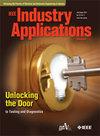Influence of Rotor Eccentricity on Electromagnetic Vibration in Toroidal-Wound High-Speed Permanent Magnet Generators
IF 4.5
2区 工程技术
Q2 ENGINEERING, ELECTRICAL & ELECTRONIC
引用次数: 0
Abstract
Rotor eccentricity faults can cause uneven air gaps in the generator, reducing power quality and increasing vibration noise, eventually leading to abnormal operation. Especially in high-speed machines, eccentric faults are more common. This paper studies the effect of static and dynamic eccentricity faults on the electromagnetic vibration of a toroidal-wound high-speed permanent magnet generator (HSPMG). Firstly, an eccentricity mathematical model is established, and the electromagnetic characteristics under different static and dynamic eccentricities are analyzed using the numerical calculation method. The spatial and temporal distribution of the air gap magnetic field under the fault is obtained, revealing the change mechanism of the magnetic field asymmetry after the eccentricity fault. Secondly, based on Fourier time-harmonic analysis, the characteristic parameters of the electromagnetic force wave under different eccentricity rates are studied, and the characteristic parameters of the introduced electromagnetic force wave components under the eccentricity fault are obtained. Finally, the vibration acceleration of the generator stator is obtained by multi-physics field coupling and harmonic response analysis, and the vibration characteristics of the stator under static and dynamic eccentricity faults are determined. The experiment is carried out to verify the analysis.转子偏心对环形高速永磁发电机电磁振动的影响
转子偏心故障会造成发电机气隙不均匀,电能质量下降,振动噪声增大,最终导致不正常运行。特别是在高速机器中,偏心故障更为常见。研究了静偏心故障和动偏心故障对环形绕线高速永磁发电机电磁振动的影响。首先,建立了偏心数学模型,采用数值计算方法分析了不同静、动偏心下的电磁特性。得到了断层下气隙磁场的时空分布,揭示了偏心断层后磁场不对称性的变化机理。其次,基于傅里叶时谐分析,研究了不同偏心率下电磁力波的特征参数,得到了偏心故障下引入的电磁力波分量的特征参数;最后,通过多物理场耦合和谐波响应分析,得到了发电机定子的振动加速度,确定了发电机定子在静态和动态偏心故障下的振动特性。通过实验验证了分析的正确性。
本文章由计算机程序翻译,如有差异,请以英文原文为准。
求助全文
约1分钟内获得全文
求助全文
来源期刊

IEEE Transactions on Industry Applications
工程技术-工程:电子与电气
CiteScore
9.90
自引率
9.10%
发文量
747
审稿时长
3.3 months
期刊介绍:
The scope of the IEEE Transactions on Industry Applications includes all scope items of the IEEE Industry Applications Society, that is, the advancement of the theory and practice of electrical and electronic engineering in the development, design, manufacture, and application of electrical systems, apparatus, devices, and controls to the processes and equipment of industry and commerce; the promotion of safe, reliable, and economic installations; industry leadership in energy conservation and environmental, health, and safety issues; the creation of voluntary engineering standards and recommended practices; and the professional development of its membership.
 求助内容:
求助内容: 应助结果提醒方式:
应助结果提醒方式:


